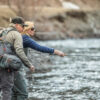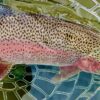
“Never throw a long line when a short one will serve your purpose.” – Richard Penn
Trout take a fly with astonishing speed…and as quickly as they take it they spit it out. To ensure a solid hook set, an angler should be as close as possible to their quarry and make a short cast. The problem, in September the water is very low and clear; because of this, the fish can be very spooky. If you get too close, the fish may go down. So this begs the question, how close should you get? The answer is not simple as each spot is different; but as a general rule, never throw a long line or a short one until you have assessed how skittish the trout are.
SILVER CREEK
If you are heading down to the Creek the key to success is staying flexible. The weather is variable and the conditions can change rapidly. On the unseasonably warm days, you may still find a few Tricos mixed with some Baetis. This hatch will not be strong enough to get fish in pods, but you will find a few surface feeders during this time. To get the bigger fish, try a dry dropper rig through the runs where you can see them holding. A small Zebra midge or WD40 can be effective in this scenario. On the cloudy days, expect the Baetis in size 18 and 22 to be the dominant hatch in the afternoon. You will need a long leader down to 6 or 6.5x and, as always on the Creek, you should position yourself so the fish see the fly first and not the leader. Of course, the Callibaetis (size 18) are still going to be a factor later in the day in the pond and sloughs. Also, Mahogany Duns (size 16) will continue to build momentum as the days get cooler. When you see this bug on the water, switch to it as the fish may tend to prefer it over all the other options available. On windy days try a terrestrial; shorten your leader down to a stout 4x and tie on a hopper or an ant and cover the likely water: cut banks, drop offs, channels between the weeds. This is best done from a float tube so you can cover a ton of water. The takes can be spectacular. If you do this, be prepared for the cold and wear an extra layer under your waders. Float tubing this time of year can be frigid.
BIG WOOD
The Wood is a fantastic fall fishery. The water is low and the fish are spread out from the fast, shallow riffles to the slow tailouts. Fishing small parachute patterns in size 16 and 18 like a Purple Haze or a Gulper Special through skinny water can be fun this time of year. You might run into some flying ants as well, so always have a few in your box. Searching the water with a hopper is also a good idea. The Red Quills, the last big mayfly of the year, are coming on strong and you should have flies to match this hatch. Remember, with the low and clear conditions, you need to approach the water with caution and scan the shallow edges and tailouts or you will spook more fish than you catch. When fishing the big bugs, like the Red Quill, a hopper, or an ant you can easily get away with using 5x, but you still need to exercise caution. Nymphing the Wood this time of year can be extremely productive. Fishing dry dropper style with a small size 16 or 18 Zebra Midge in red or black, a bead head pheasant tail, Bishop’s Dynamite, or Rainbow Warrior can turn a slow day around.
THE SALMON
The mornings are really cold in Stanley this time of year; starting your fishing before 11AM can be a waste of time. But as the air temps come up and the sun warms the water, the fishing can still be very good. There can be an October Caddis hatch on the Salmon and sometimes it starts in late September. Try size 12 or 14 Orange Stimulators to match this hatch. For the best results, focus your attention on the riffles leading into the long runs with double nymph rigs and dry dropper rigs. For dries try to include hoppers, ants, caddis, or other high floating easy to see attractors. For nymphs try small rubber legged stones, Bishop’s Dynamite, Rainbow Warriors, or any other beaded size 14 or 16 nymph.
THE UPPER LOST
Heads up…Blaine County Road and Bridge will be conducting road maintenance to the gravel portion of Trail Creek Road. Planned construction is scheduled to begin Monday September 19, 2016 – September 30, 2016. During this timeframe, Trail Creek Road will be CLOSED to all traffic during the operating hours of 8:00 a.m. – 4:00 p.m. and reopened daily at 4:00 p.m. The best fishing is on the Main Stem of the Upper Lost from the North Fork confluence and down. The river is low and the fish are spread out. Expect there to be maybe one good fish per run with only one legitimate chance at getting a strike…so make it count. With the cooler temperatures, the fishing is best from the middle of the day into the late afternoon. The Red Quills are out, and when they are on the water, the fish will be on them! For flies, take along an assortment of your favorite attractor dry flies and nymphs as well as your standard parachute patterns: Parachute Hare’s Ear, Turk’s Tarantulas, PMX, Royal Wulffs, King Prince, Flashback PTs and Zebra Midge.
BIG LOST – MACKAY
At the moment the flows are around 244 CFS and may continue to drop even more over the next few weeks. Check the Idaho River Flows link on our website to see current flows. The Tricos and Baetis are still hatching, but the cooler temperatures have moved the bug activity to the late morning and through the middle of the day. When the bugs are gone, be prepared to nymph. Of late, the fish are harder to hook, which may be because of the pressure they are under from anglers. The key to success on these fish is contact with your flies. European Nymphing techniques will increase your catch rate dramatically. For bugs, be sure to have Tricos and Baetis in size 18-20 and an assortment of nymphs such as King Princes (size 12, 14), San Juan Worms, Flashback Pheasant Tails (size 14, 16), Bishop’s Dynamite (size 14, 16, 18), and Zebra Midge (size 16,18).
SOUTH FORK OF THE BOISE
The flows have come down to a very wadable 617 CFS. The flotilla of drift boats are gone and wade fisherman now rule the waterway. Look for Pinks and Flavs along with fall Baetis to be the main course. Also craneflies will be seen skittering about with a few caddis still lingering in the evenings. If you find no bugs about, you might try a hopper as well. Nymphing is also going to be productive with the usual suspects such as PTs (size 16-20), Zebra Midge (size 18,20), as well as stoneflies and caddis larva imitations. I like nymphing with either a stone or caddis larva as an anchor fly along with a smaller midge or mayfly imitation when nothing else is going on. Fall fishing on this river can truly be spectacular.
LOCAL PONDS
Lake Creek, Penny Lake, or Gaver’s Lagoon have been stocked and will receive regular stockings throughout the summer season. These are great places for a family picnic or a fly fishing lesson. Whatever style of fishing you want to do, we are your headquarters, so drop on by and we will make sure you have the right gear to be successful.
|
Silver Creek Big Wood South Fork of the Boise The Salmon The Big Lost Copper Basin |
75 cfs 145 cfs 606 cfs 433 cfs 244 cfs 30 cfs |



